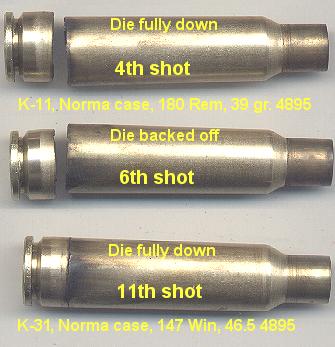Patrick, it seems you've come a long way toward appreciating some parts of the issue but still have areas of misunderstanding.
Press "spring-back" is negligible in neck sizing, simply because sizing just the neck takes very little force. Press flex is an issue when full-length sizing, especially with thick, heavy cases. The primary source of neck-sizing problems is attempting to do it with FL dies that contact the body before the neck is sized far enough. This contact often compresses the body and displaces the shoulder forward.
Smoked cases reveal body contact when attempting to neck-size with full-length sizer dies.
Head separations certainly occur with the Swiss 7.5 rifles and have been discussed at length on the forums dedicated to these arms. Here's an image from one such thread -
While fire-forming with lubed cases is an effective technique for some handloaders, others object to the practice on the grounds that it delivers unnecessary stress to the bolt and receiver. Fire-forming with some kind of spacer ahead of the rim is nearly as effective in reducing initial stretch and avoids the controversy. A spacer that also serves to center the case is additionally useful, especially with fat chambers or skinny brass.
Effective neck sizing often requires special dies, dimensioned to clear body and shoulder. It is the die position that is adjusted to give the amount of sizing desired, not the press. Most common reloading presses aren't readily adjustable in any way that affects neck sizing.
Whether or not increased stress on the rifle resulting from regular use of lubed cases is more important than reduced stress on the cases is arguable and will vary with the relative value and strength of the rifle and of the cases.
It seems pointless for a recreational handloader to obsess about gauges or varied specifications when the truly critical factor, the actual fit of his handloaded ammo in his individual rifle(s), can be determined and managed using no other gauge than the rifle itself and his "calibrated" fingers. Leave headspace gauges to gunsmiths fitting barrels or bolts, armorers or buyers checking numerous used rifles, or commercial reloaders producing ammo to be used in a variety of arms - and life gets much simpler.
- Knowledge Library

- MKL Entry of the Month
- Australia
- Austro-Hungarian Empire
- Canada
- Czechoslovakia
- Denmark
- Finland
- France/Belgium
- Germany
- Italy
- Japan
- Norway
- Russia
- South America
- Sweden
- Switzerland
- Turkey
- United Kingdom
- United States
- Yugoslavia
- Is my rifle authentic or a fake?
- Jay Currah's Lee Enfield Web Site
- On-line Service Records (Canada)
- Technical Articles/Research
- Forum
- Classifieds

- What's New?
-
Photo Gallery

- Photo Gallery Options
- Photo Gallery Home
- Search Photo Gallery List
-
Photo Gallery Search
- Video Club

- iTrader















 PM
PM
